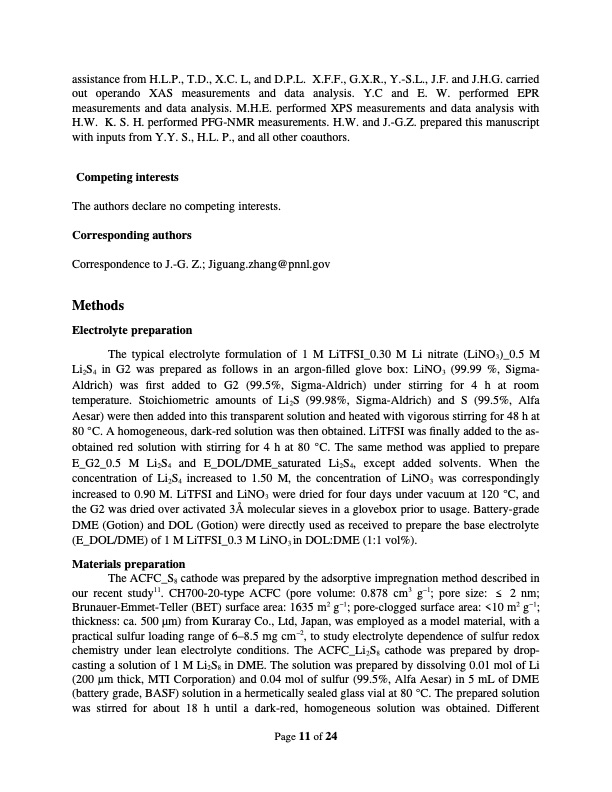
PDF Publication Title:
Text from PDF Page: 011
assistance from H.L.P., T.D., X.C. L, and D.P.L. X.F.F., G.X.R., Y.-S.L., J.F. and J.H.G. carried out operando XAS measurements and data analysis. Y.C and E. W. performed EPR measurements and data analysis. M.H.E. performed XPS measurements and data analysis with H.W. K. S. H. performed PFG-NMR measurements. H.W. and J.-G.Z. prepared this manuscript with inputs from Y.Y. S., H.L. P., and all other coauthors. Competing interests The authors declare no competing interests. Corresponding authors Correspondence to J.-G. Z.; Jiguang.zhang@pnnl.gov Methods Electrolyte preparation The typical electrolyte formulation of 1 M LiTFSI_0.30 M Li nitrate (LiNO3)_0.5 M Li2S4 in G2 was prepared as follows in an argon-filled glove box: LiNO3 (99.99 %, Sigma- Aldrich) was first added to G2 (99.5%, Sigma-Aldrich) under stirring for 4 h at room temperature. Stoichiometric amounts of Li2S (99.98%, Sigma-Aldrich) and S (99.5%, Alfa Aesar) were then added into this transparent solution and heated with vigorous stirring for 48 h at 80 °C. A homogeneous, dark-red solution was then obtained. LiTFSI was finally added to the as- obtained red solution with stirring for 4 h at 80 °C. The same method was applied to prepare E_G2_0.5 M Li2S4 and E_DOL/DME_saturated Li2S4, except added solvents. When the concentration of Li2S4 increased to 1.50 M, the concentration of LiNO3 was correspondingly increased to 0.90 M. LiTFSI and LiNO3 were dried for four days under vacuum at 120 °C, and the G2 was dried over activated 3Å molecular sieves in a glovebox prior to usage. Battery-grade DME (Gotion) and DOL (Gotion) were directly used as received to prepare the base electrolyte (E_DOL/DME) of 1 M LiTFSI_0.3 M LiNO3 in DOL:DME (1:1 vol%). Materials preparation The ACFC_S8 cathode was prepared by the adsorptive impregnation method described in our recent study11. CH700-20-type ACFC (pore volume: 0.878 cm3 g−1; pore size: ≤ 2 nm; Brunauer-Emmet-Teller (BET) surface area: 1635 m2 g−1; pore-clogged surface area: <10 m2 g−1; thickness: ca. 500 μm) from Kuraray Co., Ltd, Japan, was employed as a model material, with a practical sulfur loading range of 6–8.5 mg cm−2, to study electrolyte dependence of sulfur redox chemistry under lean electrolyte conditions. The ACFC_Li2S8 cathode was prepared by drop- casting a solution of 1 M Li2S8 in DME. The solution was prepared by dissolving 0.01 mol of Li (200 μm thick, MTI Corporation) and 0.04 mol of sulfur (99.5%, Alfa Aesar) in 5 mL of DME (battery grade, BASF) solution in a hermetically sealed glass vial at 80 °C. The prepared solution was stirred for about 18 h until a dark-red, homogeneous solution was obtained. Different Page 11 of 24PDF Image | A lithium-sulfur battery with a solution-mediated pathway

PDF Search Title:
A lithium-sulfur battery with a solution-mediated pathwayOriginal File Name Searched:
qt9bt5f7wt_noSplash_4e336387563ecb2106bd171b37448483.pdfDIY PDF Search: Google It | Yahoo | Bing
Sulfur Deposition on Carbon Nanofibers using Supercritical CO2 Sulfur Deposition on Carbon Nanofibers using Supercritical CO2. Gamma sulfur also known as mother of pearl sulfur and nacreous sulfur... More Info
CO2 Organic Rankine Cycle Experimenter Platform The supercritical CO2 phase change system is both a heat pump and organic rankine cycle which can be used for those purposes and as a supercritical extractor for advanced subcritical and supercritical extraction technology. Uses include producing nanoparticles, precious metal CO2 extraction, lithium battery recycling, and other applications... More Info
| CONTACT TEL: 608-238-6001 Email: greg@infinityturbine.com | RSS | AMP |